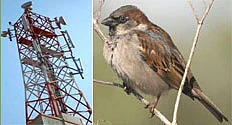
The study in Kollam taluk by environmentalist group Kerala Environmental Researchers Association (KERA) claimed that the population of house sparrow -- Passer domesticus -- is on the decline in spots like railway stations, warehouses and human dwellings normally colonized by them.
Since its diet comprises seeds, cereals and insects, factors like harmful insects, introduction of unleaded petrol, combustion of which produces highly toxic compounds like methyl nitrite, use of garden pesticides and destruction of open grasslands and mushrooming of bird unfriendly architecture also harm existence of the sparrow.
The study holds that uncontrolled and unscientific proliferation of mobile phone towers is bringing down sparrow population, said Prof Zainudeen Pattazhy, who led the study.
"Conservation of house sparrows urgently require enforcement of strict rules and regulation on erection of mobile phone towers by the Centre," he said.
The birds, which nest near towers, were found to leave them within one week. One to eight eggs are present in a clutch. Incubation takes 10 to 14 days. But eggs laid in nests near towers were found to have failed to hatch even after 30 days, the study said.
It also said mobile towers were found to emit electro magnetic waves of a very low frequency of 900 or 1,800 MHz. But this was enough to harm the thin skull of chicks and their egg shells. Hence it is imperative to include this bird in the endangered list and take steps to protect them from vanishing, the study said.
According to Pattazhy, there are more than 80 mobile towers in Kollam taluk alone. In many places, three or four towers are erected within half a kilometre radius.
A mobile tower can emit microwave radiations in the Radio Frequency Radiation (RFR) part of the spectrum of electro magnetic waves. RFR is a source of thermal energy and in adequate doses, has all known effects of heating on biological systems, including burns and cataracts in the eyes.
The heating effect of RFR can become a problem in individuals with metallic implants like rods in bones and electromagnetic interference can interact with cardiac pace makers. Acute high dose exposure to RFR may cause injury to the eyes. The cornea and lens are particularly susceptible to frequency of the 1-300 GHz range and formation of lesions in the retina is also possible.
Stout and stocky birds with shorter legs and thicker bill, house sparrows like areas modified by humans like farms, residential clusters and urban areas, where they nest in crevices inside or on the buildings.
Eggs are laid at any time in the nesting season and both males and females incubate the eggs for short periods of a few minutes each. Incubation lasts for 10 to 14 days. After the eggs are hatched, both males and females feed the young through regurgitation.
With an average life span of 13 years, they tend to forage for food on the ground, using a hopping movement when not in flight. They aggressively protect a small territory around their nests.
They have been observed to threaten and attack other birds if they intrude into their territory and use a set of postures and behaviours to communicate with others of their species. House sparrows also have a set of vocalizations that are used to attract mates, deter intruders and warn others.